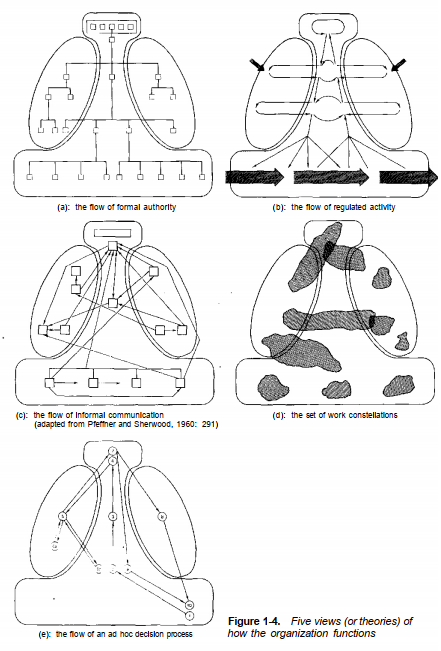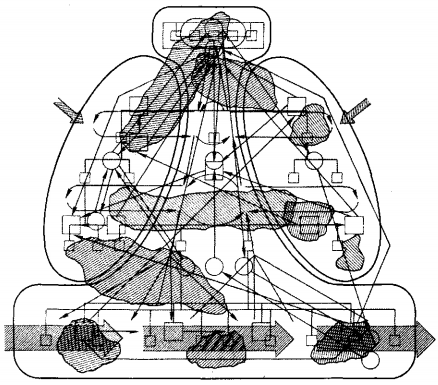Here then we have our representation of the organization in five parts. As noted, we can and shall use this diagram in various ways. One way is to overlay the diagram with various types of flows to depict how the organi- zation functions, at least as has been characterized in the literature of management. Figure 1-4 shows five of these flows. Each represents, in a sense, a distinct theory of organizational functioning. .
Figure l-4a represents the organization as a system of formal authori-ty—the flow of formal power down the hierarchy. What we have here is an organization chart (I prefer the term organigram, borrowed from the French) overlaid on our logo. The organigram is a controversial picture of the structure, for although most organizations continue to find it indis- pensable (the organigram is inevitably the first thing handed to anyone inquiring about structure), many organizational theorists reject it as an inadequate description of what really takes place inside the organization. Clearly, every organization has important power and communication rela- tionships that are not put down on paper.
However, the organigram should not be rejected, but rather placed in context. It is somewhat like a map. A map is invaluable for finding towns and their connecting roads, but it tells us nothing about the economic or social relationships of the regions. Similarly, even though the organigram does not show informal relationships, it can represent an accurate picture of the division of labor, showing at a glance (1) what positions exist in the organization, (2) how these are grouped into units, and (3) how formal authority flows among them (in effect, describing the use of direct supervision).
Figure l-4b depicts the organization as a network of regulated flows of production work through the operating core, of commands and instruc- tions down the administrative hierarchy to control the operating core, of feedback information on results (in a management information system, or MIS) back up, and of staff information and advice feeding into decision making from the sides. This is a view of the organization consistent with traditional notions of authority and hierarchy, but, unlike the first view, one that places greater emphasis on standardization than on direct supervision.

Figure l-4c describes the organization as a system of informal commu- nication, emphasizing the role of mutual adjustment in coordination. What we have here, in fact, is a “sociogram”—a map of who actually communi- cated with whom in a study of one municipal government (drawn from the work of Pfiffner and Sherwood, 1960). What this view of the organization indicates is that unofficial centers of power exist in organizations and that rich networks of informal communication supplement and sometimes cir- cumvent the channels of authority and regulation. The neatness of the first two views disappears in this third one.
Figure l-4d depicts the organization as a system of work constellations. The underlying view here is that people in the organization cluster into peer groups (not related to the hierarchy or even necessarily to our five parts) to get their work done. Each cluster or constellation deals with distinct decisions appropriate to its own level in the hierarchy, and is only loosely coupled to the others. Here,’ then, in contrast to the organization as a kind of orderly spiral spring of the first two views, and as a confusing marble cake of the third, we see it as a kind of semiorderly layer cake. In Figure l-4d, in terms of a typical manufacturing firm, we have three work constellations in the operating core—one concerned with fabrication, a second with assembly, a third with distribution. Above them is an admin- istrative production constellation, comprising analysts and first-line super- visors, concerned with production scheduling and general plant admin- istration. Above that is a new-product constellation, including analysts, line managers, and support staffers (such as researchers). Exclusively with- in the support staff are three constellations, concerned with the plant caf- eteria, research and development (overlapping the new-product constella- tion), and public relations. Finally, at the top, the finance constellation connects senior managers with the financial support staff, and the long- range-planning constellation joins senior managers with senior analysts of the technostructure.
Last is Figure l-4e, which depicts the organization as a system of ad hoc decision processes. What we have in this overlay is the flow of one strategic decision, from beginning to end (but, like all the other overlays, vastly simplified). At point 1, a salesman meets a customer, who suggests a modification in a product. The suggestion is taken up at successively high- er levels in the hierarchy (2, 3, 4), until a decision is made at the top (4) to create a task force of analysts and line managers to investigate it and make recommendations (5, 6). Senior management approves the subsequent rec-ommendations to introduce a new product (7), and implementation pro- ceeds (8, 9). The salesman eventually returns to the customer with the new product (10).
We now have five views or theories of how the organization func- tions. Which is correct? Clearly, by itself, none is. Each is a gross simplifica- tion of organizational reality. Yet each contains a grain of truth. Only by combining them, as we have done in Figure 1-5, do we begin to get a sense of the true complexity of the functioning of the organization. It is this complexity with which we must now deal.
With this foundation laid—our five coordination mechanisms as the glue of structure, our five parts making up our logo or theme diagram, and our point just made about the complexity of the functioning of the organi- zation—we can begin our story of the structuring of organizations. We start with the design parameters, those levers that can be pulled and knobs that can be turned to affect the division of labor and the coordination of tasks in the organization. We discuss these in four chapters, the first on parameters that can be used to design individual positions in the organiza- tion, the second on parameters to design the organization’s whole super- structure, the third on parameters used to flesh out that superstructure, and the fourth on parameters used to design the decision-making system of the organization (that is, related to its “decentralization”).

Figure 1-5. A combined overlay: the functioning of the organization
Then we devote a chapter to the situational factors, in an attempt to put the parameters of design into context. Here we consider how the various design parameters should be influenced by the age and size of the organization, the technical system it uses, the environment in which it operates, and the power relationships that surround and infuse it.
This brings us to the meat of the book, our synthesis of the preceding materials—the configurations. In Chapter 7, we introduce our basic five:
- Simple Structure, based on direct supervision, in which the strategic apex is the key part
- Machine Bureaucracy, based on standardization of work processes, in which the technostructure is the key part
- Professional Bureaucracy, based on standardization of skills, in which the operating core is the key part
- Divisionalized Form, based on standardization of outputs, in which the middle line is the key part
- Adhocracy, based on mutual adjustment, in which the support staff (sometimes with the operating core) is the key part
Five subsequent chapters discuss each of these configurations at length—its basic combination of design parameters, how it functions, the conditions under which it is appropriately found, and various issues, social as well as managerial, associated with its functioning. The final chapter of the book, titled “Beyond Five,” takes up the one unanswered question of this chapter: Is five the magic number in the design of effective organi- zations?
Source: Mintzberg Henry (1992), Structure in Fives: Designing Effective Organizations, Pearson; 1st edition.
